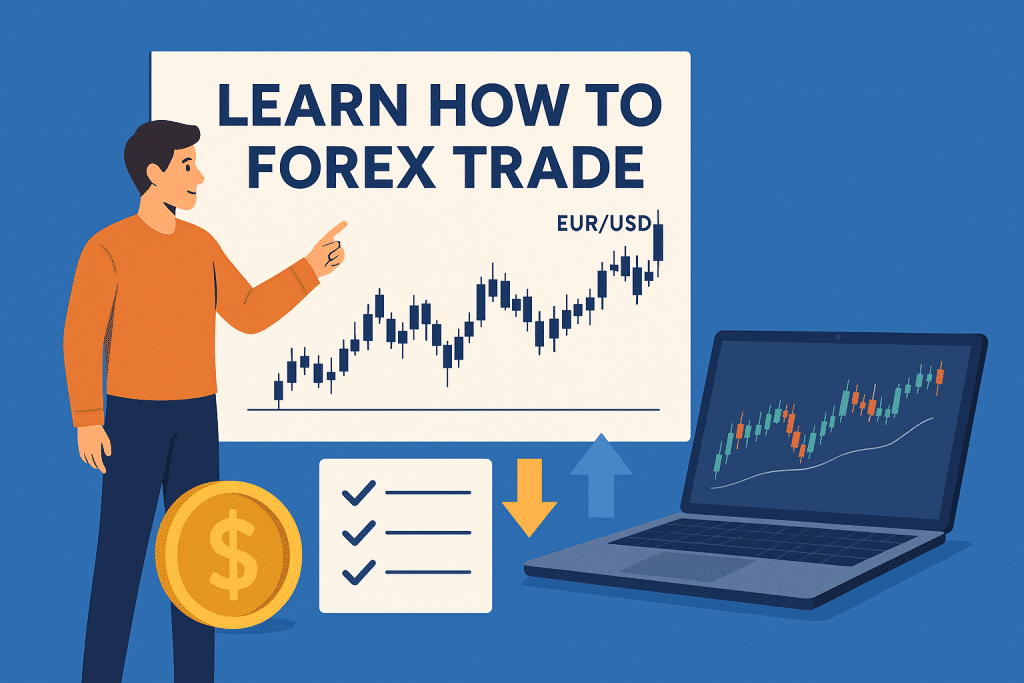Learn How to Forex Trade

Learning how to forex trade is the first step towards participating in the largest and most liquid financial market in the world, where currencies are exchanged 24 hours a day. Successful traders combine knowledge, practice, and strategy to navigate the market effectively. This guide will walk you through the essentials of forex trading, including market basics, strategies, risk management, and practical tips to start your journey.
Understanding Forex Trading Basics
Forex, or foreign exchange, involves buying one currency while simultaneously selling another. Currencies are traded in pairs such as EUR/USD or GBP/JPY, where the first currency is the base currency and the second is the quote currency.
- Major pairs: EUR/USD, GBP/USD, USD/JPY, USD/CHF
- Minor pairs: EUR/GBP, GBP/JPY, AUD/NZD
- Exotic pairs: USD/TRY, EUR/ZAR
Forex trading occurs over-the-counter (OTC) and is influenced by macroeconomic events, interest rates, and geopolitical developments.
Key Market Participants
- Central banks and governments
- Commercial and investment banks
- Hedge funds and institutional investors
- Retail traders using online brokers
Understanding who moves the market helps traders anticipate volatility and identify trading opportunities.
Essential Tools and Platforms
To learn how to forex trade, you need a reliable trading platform and the right tools:
- MetaTrader 4 (MT4) or MetaTrader 5 (MT5) – Industry-standard platforms
- cTrader – Popular for its advanced execution and charting tools
- TradingView – Ideal for chart analysis and social trading insights
Professional traders recommend using demo accounts to gain experience without risking real capital.
Developing a Forex Trading Strategy
A trading strategy provides structure and discipline. Some widely used strategies include:
1. Scalping
- Focuses on small price movements over minutes or seconds
- Requires fast execution and tight spreads
- Works best in high-liquidity markets like EUR/USD
2. Swing Trading
- Targets medium-term trends lasting days or weeks
- Uses technical indicators like MACD, RSI, and moving averages
- Suitable for traders who cannot monitor the market constantly
3. Trend Following
- Identifies long-term market direction
- Combines moving averages and breakout levels
- Performs best in markets with strong momentum
Example
Traders report that combining MACD and RSI on the 4-hour chart improves entry timing for swing trades on GBP/USD.
Risk Management in Forex Trading
Learning how to trade forex effectively requires a deep understanding of risk management:
- Never risk more than 1–2% of your trading capital per trade
- Use stop-loss orders to limit downside risk
- Maintain a risk-to-reward ratio of at least 1:2
- Avoid over-leveraging; excessive leverage magnifies losses
Verified trading reports show that consistent risk management is the primary difference between long-term profitable traders and those who fail.
Real-World Case Study: A Beginner’s Journey
Emma, a beginner trader from London, started learning forex using a demo account for 3 months. She focused on EUR/USD swing trades, applied strict risk management, and kept a trading journal.
After switching to a small live account:
- She risked 1% per trade
- Recorded 65% profitable trades in the first two months
- Gradually increased position sizes after consistent performance
This approach highlights the power of practice, patience, and structured learning.
Key Takeaways
- Learn currency pair mechanics and market participants first
- Use demo accounts to gain hands-on experience before risking money
- Adopt a trading strategy that fits your schedule and risk tolerance
- Implement strict risk management to protect your capital
- Track your trades to continuously improve performance
Frequently Asked Questions
How long does it take to learn forex trading?
Most beginners take 3–6 months of consistent study and demo trading to understand the basics before trading live.
Do I need a lot of money to start forex trading?
No. Many brokers allow you to start with as little as $100, but proper risk management is essential.
What is the safest way to start trading forex?
Start with a regulated broker, use a demo account, and apply strict risk management before going live.
Which is the best strategy for beginners?
Swing trading is often recommended because it is less stressful, requires less screen time, and focuses on medium-term trends.
How can I avoid losing money in forex?
Avoid over-leverage, use stop-loss orders, and never risk more than 1–2% of your capital on a single trade.

